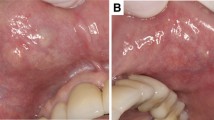Background:
The polymorphous low-grade adenocarcinoma of the nasopharynx is a rare disease. Polymorphous low-grade adenocarcinoma is a minor salivary gland neoplasm which occurs frequently in the mucosa of the soft and hard palates, in the buccal mucosa and in the upper lip. To date this entity has been identified within the oral cavity and only one case within the nasopharynx and some cases in the parotid gland. It has a slow infiltrating growing pattern with frequent perineural invasion and low metastatic potential.
Case Report: We report on a patient with non-papillary polymorphous low-grade adenocarcinoma in the nasopharynx which extended intracranially. The patient underwent primary radiotherapy. The CT showed partial response to radiotherapy and the patients is alive 51 months after the diagnosis his state being unchanged. Conclusion: The treatment for minor salivary gland tumor is primarily surgical. It is reported that the polymorphous low-grade adenocarcinoma has been known to have poor response to radiotherapy. However, we believe that in addition to its favorable biological behavior, the radiotherapy in this localization may result in longer survival.
Hintergrund:
Das polymorphe Adenokarzinom des Nasopharynx mit niedrigem Malignitätsgrad ist eine seltene Krankheit. Es handelt sich um eine Geschwulst der kleinen Speicheldrüsen, die oft in der Schleimhaut des harten und weichen Gaumens, in der Mundschleimhaut und in der oberen Lippe vorkommt. Diese Krankheitsform wurde bisher in der Mundhöhle, nur in einem Fall im Nasenrachenraum und in einigen Fällen in der Ohrspeicheldrüse nachgewiesen. Sie zeigt ein langsam infiltrierendes Wachstum, oft mit perineuraler Invasion und geringem metastatischen Potential.
Fallbeschreibung: Wir berichten über einen Patienten mit intrakranial ausgedehntem nichtpapillären polymorphen Adneokarzinom des Nasopharynx. Der Patient erhielt eine primäre Strahlenbehandlung. Durch CT wurde danach eine partielle Regression nachgewiesen. Der Patient lebt seit 51 Monaten ohne Rezidiv.
Schlußfolgerung: Die Therapie des Speicheldrüsenkarzinoms ist in erster Linie eine chirurgische. Es ist bekannt, daß das polymorphe Drüsenkarzinom mit niedrigem Malignitätsgrad auf Strahlenbehandlung nur wenig reagiert. Wir sind aber der Überzeugung, daß die Strahlenbehandlung zur Verlängerung des Überlebens beiträgt.
Similar content being viewed by others
Author information
Authors and Affiliations
Additional information
Submitted: 2 June 1999. Accepted: 10 Nov 1999
Rights and permissions
About this article
Cite this article
Lengyel, E., Somogyi, A., Gõdény, M. et al. Polymorphous Low-Grade Adenocarcinoma of the Nasopharynx Case Report and Review of the Literature. Strahlenther Onkol 176, 40–42 (2000). https://doi.org/10.1007/PL00002304
Issue Date:
DOI: https://doi.org/10.1007/PL00002304




